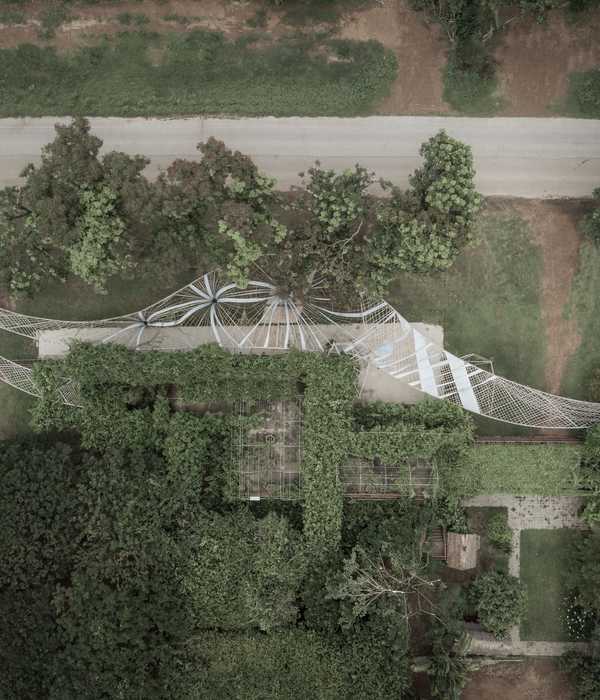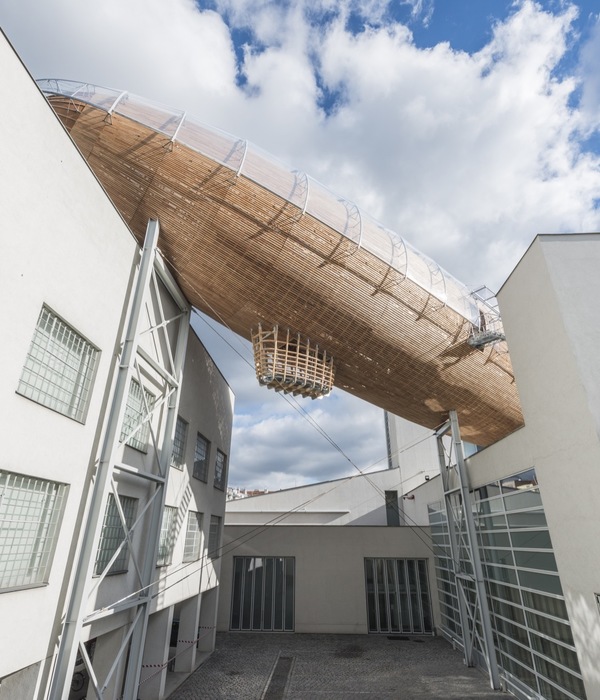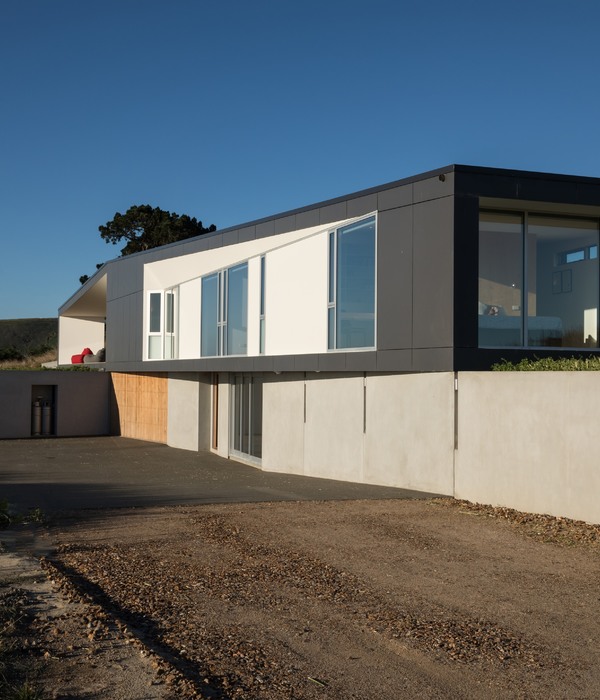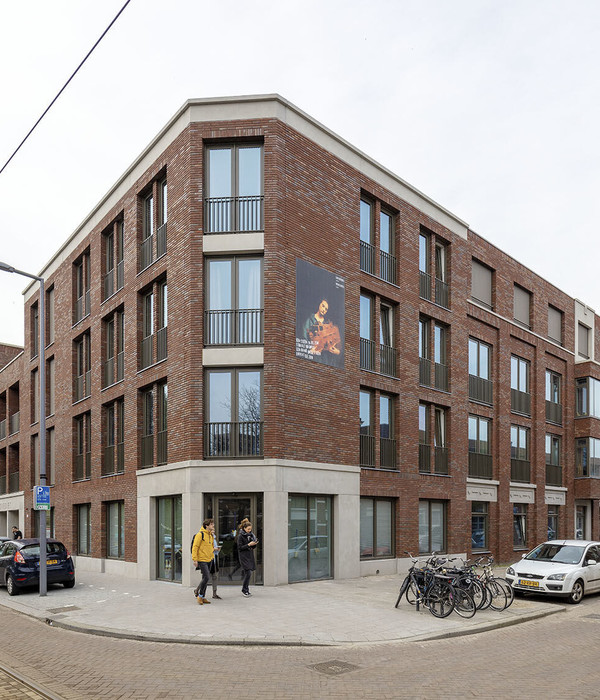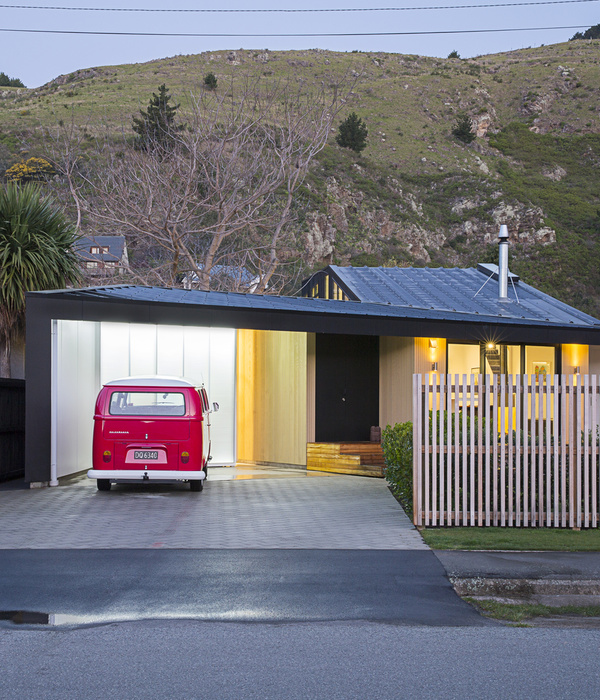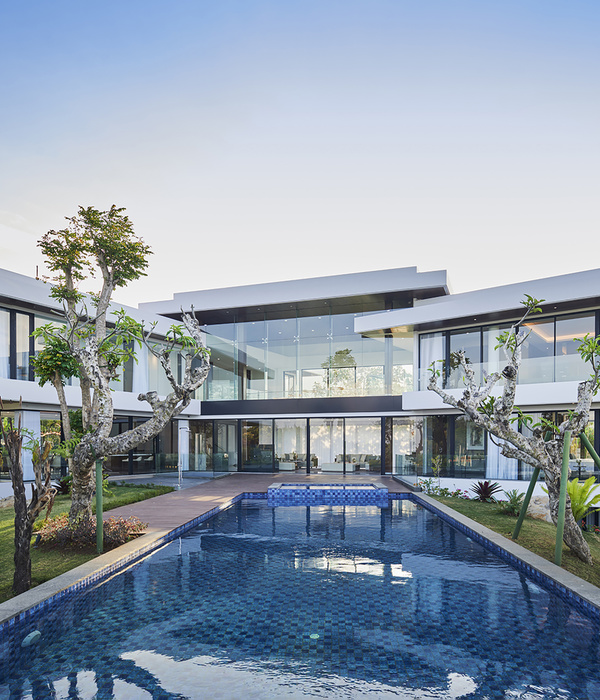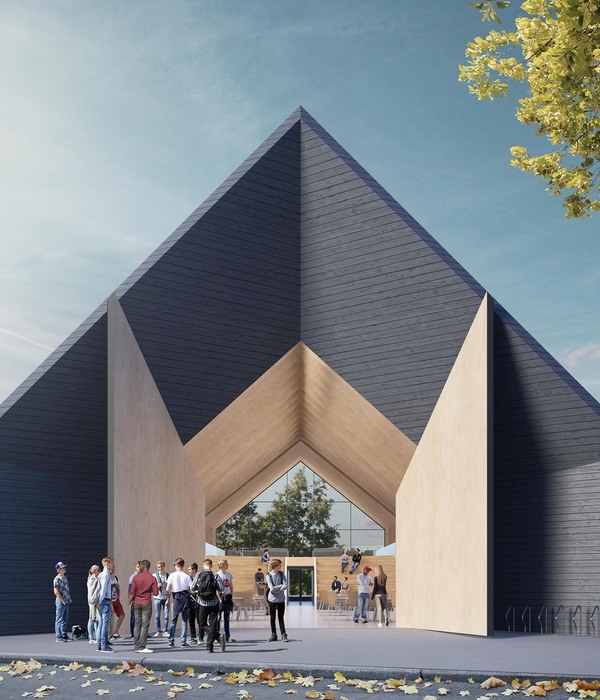- 项目名称:风之亭
- 委托方:龙山源绿郡
- 施工方:浙江竹境文化旅游发展股份公司
- 结构设计:彭超(华东建筑设计研究总院)
- 景观设计:龙山源绿郡
“风之亭”是位于安吉龙山源的一座竹结构建筑,为游人提供休憩的场所,并容纳小型演出和团建活动。设计捕捉到不同面向的景观特质,采用了分岔的人字形棚屋作为空间原型。充分发掘竹结构复合增强的潜力,独创性地提出了弦支竹梁+边拱的复合构型,大大减少了结构落地的数量,实现了轻盈而连续的曲面覆盖。最终的空间好像风吹过,帘篷鼓胀起来,唤起了人们在自然中受到庇护的原始感受。
Wind Pavilion, a bamboo-structured building located at the Longshanyuan in Anji city, serves tourist as a place for the rest, a small group as an accommodation for performances and a company as team building events. The design captures various landscapes characteristics from different aspects and uses bifurcated herringbone sheds as the spatial prototype. With fully explored bamboo’s potential structure of composite and reinformation, we proposed originally a composite configuration of string-supported bamboo beam and side arches, which greatly reduces the amount of frames landing on the ground and realizes a curved surface with lithe and coherence. When the wind blows, the eventual space seems like an expensive canopy, evoking people’s initial feeling of being protecting from nature.
▼风之亭外观,exterior view ©龙山源
基地选址在一个具有公共潜质的坡地上,紧邻一个三岔路口。主路是一条5 m宽的土路,沿着东西方向连接人文园区和自然遗址园区。岔路是一条3 m宽的小路,连接着西侧供烧烤的台地以及南面更低处的果园和田野。基地西低东高,在道路一侧的坡度约为13%,绝对高差约3 m。基地内部分为平整地面,东部、南部都有明显陡坡。设计希望顺应地形,最大化利用现有景观资源,创造开放而连续的建筑空间。
▼鸟瞰图,aerial view ©龙山源
The site is selected on a slope with public potentials and next to a divergence. The main road is a 5cm wide packway connecting the Humanity Park and Natural Heritage Park along the east-west direction. The divergence is a 3cm wide path, which connecting a terrace on west side for barbecues, and a orchard and fields lower on the south side. The base is low in the west and high in the east side. The slope on one side of the road is approximate 13%, and the absolute height difference is about 3m. The inter ground in base is partially flat, with obvious steep slopes in the east and south part. The design hopes to conform to the terrain, in order to maximize the use of existing landscape resources and create a open continuous architectural space.
▼主路入口,main entrance ©陆婕祎
▼入口高差,changing heights of the site ©张婷
▼隐藏在洞口处的人字撑细部,details of the structure ©张婷
场地条件和竹子的结构特性激发了空间的初始意向:分岔的人字形棚屋,以连续的曲面屋顶覆盖在起伏的地形上,向三个方向的景色打开,宛如风吹过拂起的帘篷。结构利用分岔的几何特性进行整合优化,并通过弦支梁与复合构件的使用最大程度地减少落柱,确保漫步的自在体验。
The conditions of the site and structural characteristics of the bamboo inspired the initiative intention of the space. The bifurcated herringbone shed covered with a coherent curved roof on the undulating terrain, open to different sceneries in three directions, which like the canopy blown softly by the wind. The structure is integrated and optimized using the geometric characteristics of the bifurcation, and use chord beams and composite components to minimize ground columns within a maximum possibility, in order to ensure a comfortable experience of walking.
▼连续的曲面屋顶,a coherent curved roof ©张婷
场地的高差被积极地组织到内部空间之中,形成高低两处活动空间,并由一条斜穿的捷径串联。最终设计的基本构成由覆盖、构架、地形共同完成。
The height difference of the site is actively organized into the internal space, forming two activity spaces with one high and one low, which are connected by a diagonal shortcut. The basic composition of the ultimate design is completed together by covering, framing, and terrain.
▼屋顶向三个方向的景色打开,open to different sceneries in three directions ©陆婕祎
主结构由弦支竹梁、人字束柱、边拱组成,分布在空间的中轴和边缘;覆盖则作为次结构,发挥拉结的作用。竖向的支撑结构为人字束柱,柱脚岔开,形成“人”字,抵抗竖向及侧向荷载。弦支竹梁作为横向的跨越结构,实现了直径约14m的无柱空间,减少结构落地以支持空间的概念。
The main structure is composed of string-supported bamboo beams, herringbone columns and side arches, which are distributed on the central axis and edges of the spaces. The covering is regarded as a secondary structure to play a role as a tie. The vertical supporting structure is the herringbone column. With the column feet diverging to herringbone type, the structure resists vertical and lateral loads. As the horizontal spanning structure, string-supported bamboo structure realizes a column-free space with a diameter up to 14m and supports the concept reducing structures on the ground.
▼天窗下部的空间,the interior space ©张婷
3个边拱将不同方向的景色引入建筑内部,同时也是身体穿过或停留的空间,为开敞的空间提供了亲密的尺度关联。西侧和北侧的边拱由多根竹子组成,形成对应南侧果园田野和北侧主路的开口;南侧边拱则通过竹桁架实现小剧场无柱空间16m的跨度,并解决单根竹子檩条的长度限制问题。
▼结构简图,diagram of structure ©同济大学建筑与城市规划学院
The three side arches bring sceneries from different directions into inner pavilion, meanwhile when the body passing through or staying still, the space provides an intimate scale connection in a open space. The side arches on the west and north are composed of multiple member of bamboos, forming a opening corresponding to the orchard and fields on the south side and the main road on the north side. The side arches on the north use bamboo trusses achieving a 16m spanning small theater without a column and solve the problem of length limitation for per single bamboo purlin.
▼竹子搭建的“人”字结构,main structure composed of string-supported bamboo beams ©张婷
▼通过竹桁架实现无柱空间,achieving a small theater without a column ©张婷
坡地被一道斜向的路径穿过,串联起两个主要的活动平台,吸纳着来自各个方向动线,并将空间紧密地扭结在一起。两个主要平台的标高差定为1.2 m,使得视线可以轻松穿越不同区域。较低的休憩平台靠近烧烤台地和通往田野的小路,结合挡土墙设置了操作台面和坐凳,成为可以和附近场地联动使用的休憩场所。
The slope is crossed by an oblique path, connecting two main activity platforms, absorbing moving lines from all directions , and tightly tying spaces together. The elevation difference is set as 1.2m, which allows the vision looking through different areas easily. The lower recreation platform is close to barbecue platform and path leading to the fields. Combined with the retaining wall, the operating table and benches are set up to become a resting place which can be used as a connection with nearby venues.
▼休憩平台与低处的田野,platform on the field ©张婷
剧场位于较高标高的平台,并结合东南侧陡坡的挡土,设置嵌入山体的环形座椅,顺应地形形成可以容纳百人的小剧场。座椅同时也是台阶,人们可由此走上山坡,眺望田野。
The theater is located on a Leigh-elevation platform. Combining with the steep slope of the southeast side, a ring-shaped seats are embedded in the mountain and conforming to the terrain, the theater which can accommodate around 100 people, are formed. The steps are seats as well, form which people can walk up to the hill and look out over the fields.
▼剧场空间与坡道,theatre and slope ©张婷
▼剧场空间与高处的山坡,theater and the surroundings ©张婷
根据空间和结构的要求,风之亭设计并使用了3种层级的构件,不同构件间几何和位置的错位组合促成了屋面的自由形态以及内部富有动感的空间感受。
According to the requirement of space and structure, Wind Pavilion designs and uses 3 levels of components. The geometric and positional misalignment combinations which are among different components promotes the free from of the roof and the dynamic spatial feeling in inside.
▼天窗细部,details ©邓希帆
统领整体的是弦支竹梁和束柱人字撑。为了实现中央直径约14 m的无柱大空间,梁上弦使用了6根拼接毛竹,下弦使用了12 mm的钢索和80 mm的钢撑杆;每组人字撑使用10根直径为10 cm的毛竹。第2层级的构件是3个边拱,对屋面的三边进行支撑。较小跨度的拱(8 m、12 m)以3根拼接成束;剧场一侧的边拱跨度16 m,采用了空间竹桁架的方式。第3层级的构件是屋面檩条,直接采用8 cm直径的热弯毛竹铺设。
What dominates the whole part are string-supported bamboo beams and herringbone columns. In order to implement a central diameter about 14m large space without any columns, the upper chord of the beam uses 6 spliced bamboos, and lower chord uses 12mm steel cables and 80mm steel struts. Every herringbone applies ten 10cm moso bamboo. The second level components are 3 side arches, which supports 3 sides of roof. The arch with smaller span(8m, 12m) are spiced into bundles by 3. The side arch which on the other side of the theater has the span of 16cm and uses a way of spatial bamboo truss. The third-level components is the roof purlin, which directly lays with 8cm hot-bent moso bamboo.
▼航拍图(局部)红点位置为“风之亭”所在地,the site ©龙山源
▼轴测图,axonometric ©同济大学建筑与城市规划学院
▼总平面图,general plan ©同济大学建筑与城市规划学院
▼平面图,plan ©同济大学建筑与城市规划学院
▼北立面,north elevation ©同济大学建筑与城市规划学院
▼西立面,west elevation ©同济大学建筑与城市规划学院
▼A-A剖面,section ©同济大学建筑与城市规划学院
▼构造细部图,structure details ©同济大学建筑与城市规划学院
学生设计团队: 邓希帆、黄于青、王梓童、白一江、易锦球、陆婕祎、潘颖嘉、林子涵 指导教师设计团队:张婷(同济教师)、彭超(结构师/华东院)、董晓(建筑师/上海博风)、肖闻达(建筑师/城间所)、谭峥(同济教师) 委托方: 龙山源绿郡 结构设计: 彭超(华东建筑设计研究总院) 景观设计: 龙山源绿郡 施工方: 浙江竹境文化旅游发展股份公司 竹结构施工技术顾问:王燕飞、马巨东
▼项目更多图片
{{item.text_origin}}



